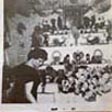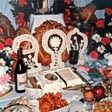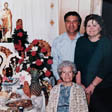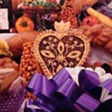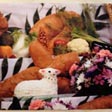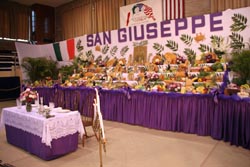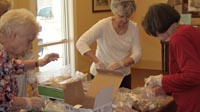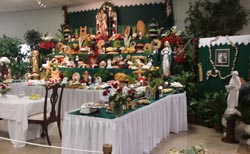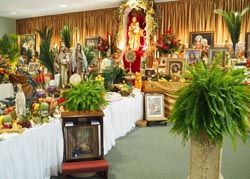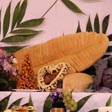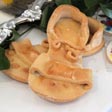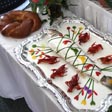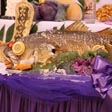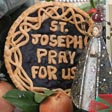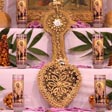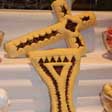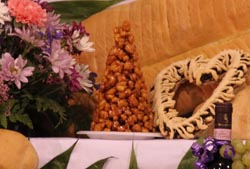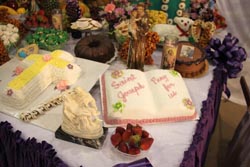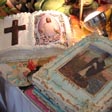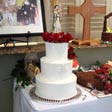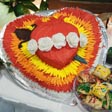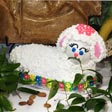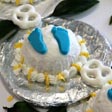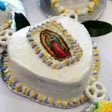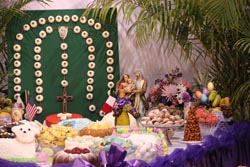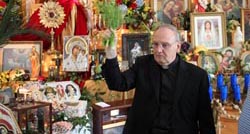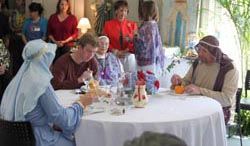St. Joseph's Altars: Faith in Tradition
By Laura Marcus Green
Old Roots in the New World
For Anthony and Carolyn Musso, the St. Joseph altar tradition has deep family and cultural roots. During the latter part of the 19th century, Anthony's great-grandfather was among a generation of Sicilians who crossed the Atlantic each year to cut sugar cane along the Mississippi River between Baton Rouge and New Orleans. These men worked from August until February, returning home to Sicily at the end of the season. At that time, their help was needed in Louisiana to weather a labor shortage following the Civil War. As a young man, Anthony Musso's grandfather began accompanying his father to work the sugar cane season. Ultimately, in around 1900, he settled permanently in Louisiana, bringing his wife and daughter, Lena, to the area. The family grew and eventually saved enough money to buy property in Plaquemine Point, in Iberville Parish.
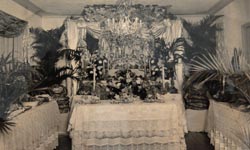
As a Sicilian community took shape in Louisiana, cherished traditions from home became part of the Bayou State's multicultural landscape. One enduring Sicilian legacy is the St. Joseph altar, held on or around his feast day, March 19th. As a boy, Anthony Musso grew up with the St. Joseph altar tradition. Typically, someone in his family hosted an altar each year. At that time, the altars were held in private homes, and were often advertised in the newspaper. Anthony remembers when there were at least 15 altars every year in Baton Rouge. The eve of St. Joseph's Day was dedicated to visiting with the altar hosts and looking at the altars. The custom was to try and attend seven altars on that evening. According to the Mussos, the practice of attending seven altars was a form of penance, believed to confer special favors or blessings upon those who achieved this goal. On the feast day itself, people would go and eat at one of the altars.
Anthony's maternal great uncle, Pete Ferruggia, immigrated to Louisiana from Sicily at around the turn of the 20th century. In his New Orleans home, he faithfully hosted a St. Joseph altar for 58 years. Anthony remembers that his Uncle Pete's home was next door to a South Central Bell telephone office. Each year, workers from the office would come to his uncle's altar and enjoy a meal of spaghetti and all the trimmings. Uncle Pete made his last altar in 1975, the year he turned 90, in fulfillment of a promise that he would live to that age.
The 1945 publication, Gumbo Ya-Ya: A Collection of Louisiana Folk Tales, contains a chapter on St. Joseph's Day. The publication is a collection of Louisiana folklore, gathered by researchers for the Works Progress Administration and the Louisiana Writers Project. Their accounts of St. Joseph's Day include a sample Personal Column from a period newspaper, with public invitations to attend St. Joseph altars in private New Orleans homes. Among the listings is the following: "Mr. and Mrs. P. Farrugia, 1301 Prytania Street, invite you to visit their St. Joseph's Altar" (Saxon, et. al. 1945: 98).
As noted above, Anthony's aunt, Lena Musso Puccetti, came to Louisiana from Sicily as a little girl in around 1900. When she was old enough, she assisted with the family's St. Joseph altar in Plaqueimine Point. As an adult living in New Orleans, she was one of Pete Ferruggia's primary helpers on his St. Joseph altar each year. After Pete passed away, Aunt Lena inherited the role of hosting the family's altar. Her dining room was small, so her altar was considered a St. Joseph "table." Some 1988 photos from the Musso family album show Aunt Lena's table, for which she made everything, including the special cookies, pastries, cakes, and other foods. Only the bread was purchased from a bakery. A bowl containing money can be seen in the foreground of a photo of the Mussos with Aunt Lena, who was in her nineties at that time. Some of the funds left by visitors seeded the following year's altar and the rest went towards a pool of funds held in reserve by Aunt Lena's church for those in need.
Looking at the photos and musing on the transition from Uncle Pete's large altar to Aunt Lena's table-sized one, Carolyn Musso observed, "So it shows you, no matter where you had it, it didn't matter if it was in a big home or you just had one room, this is their faith and what they did." Aunt Lena never had the opportunity to attend school and learn to read or write. Her altar decorations were a testament to her artistic ability. All of the recipes for the special Italian cakes and cookies were stored in her memory. When Anthony and Carolyn married, Aunt Lena made every type of Italian cookie for their wedding, in keeping with the custom.
Carolyn Musso remembers her first St. Joseph's Day. Anthony chose the occasion of the altar that year to introduce her to his family. Since then, the St. Joseph altar has been an important part of her life, as she has embraced her husband's cultural roots. Together, the Mussos have ensured that their children and grandchildren know about and appreciate their Italian heritage. Carolyn has collected traditional Sicilian recipes that she has compiled into a cookbook for her children and grandchildren, as part of their cultural legacy. She has also commissioned a local woodworker to make the specialized rolling pins used to make the fig cookies for St. Joseph altars. She ordered one for each of her children and grandchildren, to keep the tradition going for generations to come. Anthony has taken his grandchildren to Sicily, where they visit a cousin in Roccamena, the family's ancestral home. The Mussos also visit Rome, where they experience highlights of Italian culture and history.
A Companion for Life: Betty Schoettle's St. Joseph Traditions
Like Anthony Musso, Elizabeth (Betty) Schoettle grew up with the St. Joseph altar tradition in her native New Orleans. Betty first knew St. Joseph through her father, who had a deep devotion. Betty's parents did not have children during the first three years of their marriage. While her mother prayed to St. Anne to be able to have children, her father prayed to St. Joseph, promising that if they had a child he would do his best to be a good father. He began devotions to St. Joseph and wore a St. Joseph medal around his neck. He always carried his St. Joseph novena book with him and prayed his rosary every day.
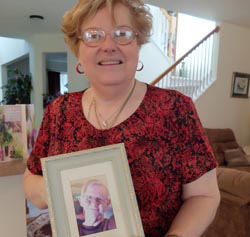
Although not Sicilian, Betty's family was close to their Sicilian neighbors, the Grecos, a relationship already three generations deep when Betty was growing up. Mary Greco, who was of Betty's parents' generation, was very involved in the St. Joseph altar tradition. From her middle school years, Betty remembers her father going to help Mary on "Pignolata Sunday." This was a day devoted to the painstaking work of creating pignolata, pinecone-shaped cookies made from small fried balls of dough held together with a syrup. Beyond the Grecos' altar activities, St. Joseph's Day was a big part of Betty's childhood. Betty attended school in New Orleans' Lower Ninth Ward, where at that time German, Irish, French, and Italian extended families lived together. She remembers visiting altars in people's homes on the eve of St. Joseph's Day, going from house to house, on an annual "family field trip."
Betty's family eventually moved to St. Bernard Parish, where she spent her 33-year career in education. In this neighborhood, people attended larger public altars hosted by the Knights of Columbus and St. Mark's Catholic Church. Betty recalls the transition to the larger public altars in around the 1970s, when people no longer felt safe hosting home altars and advertising them in the newspaper. This shift mirrors broader changes in our society. Anthony Musso likewise witnessed this evolution. In addition to concerns about security, he feels that as his parents' generation aged and passed away, the private altars became too much of a burden for one family. The public altars distribute the work, with many more hands contributing to one or more larger-scale altars. The public altars have kept the St. Joseph altar tradition vibrant in Louisiana, while adapting to contemporary times. Nonetheless, the spirit of this ritual, its basic format and special foods have largely remained the same as when the altars were held in private homes.
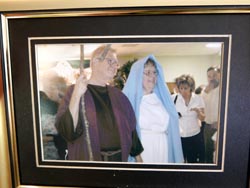
Over time, Betty's father became increasingly involved in helping Mary Greco prepare St. Joseph altars. Betty's father was a talented baker and chef, who readily took to preparing the special altar breads and pastries. Mary continued to create private home altars for families who needed a special devotion to address an illness or other situation. Betty's father also began to assist with the St. Joseph altar at St. Frances Xavier Cabrini Catholic Church, for which he made all of the breads and the cuccidati, special fig pastries. Betty explains the special connection with Mother Cabrini, who was Italian and who spent time in New Orleans. According to Betty, the St. Joseph altar began at St. Frances Cabrini as a way to teach the children who attended school there the history of this tradition.
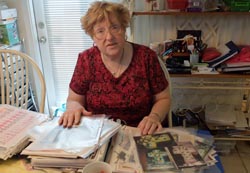
The death of Betty's father in 1990 heralded a deepening of her relationship with the St. Joseph altar tradition. Following her father's passing, the nuns at St. Frances Cabrini asked for a photo of her father for their altar the following spring, as they dedicated the altar to him that year. The nuns knew Betty, as she attended their altar on the eve of St. Joseph's Day each year. As an elementary school principal, she was unable to attend the actual meal on the saint's day. She promised the nuns that when she retired she would help them with the altar, to help fill the void left by her father's passing.
Following her father's death, Betty reconnected with longtime family friend Milton Schoettle. Betty and Milton rekindled their friendship, which ultimately blossomed into marriage. Around that time, having neglected her own health while caring for her ailing father and grandmother, Betty was facing a surgery on March 21st, just days after St. Joseph's day. That year, on March 18th, she put her petition on the altar, asking St. Joseph for a pain-free surgery and a long and happy life with Milton. She came through the surgery pain-free, made a quick recovery and returned full-time to her demanding work schedule by May 1. She also enjoyed 19 happy years with Milton.
Betty and Milton were married on March 19th, St. Joseph's Day, further adding to the significance of this date in their lives. Betty's wedding bouquet consisted of St. Joseph lilies from her garden. At their wedding, a small table was dedicated as an altar to St. Joseph, complete with statues of St. Joseph and the Holy Family, St. Joseph prayer cards, and special cookies prepared by the Italian cafeteria workers at the school where Betty was principal.
By the time Betty retired in 1999, Mary Greco was getting up in years. Betty and Milton helped her with her St. Joseph altar preparations, which she insisted on doing completely by hand. They used an old-fashioned meat grinder to prepare the fig filling for the cuccidati. Although she accepted their help with various steps in the process, Mary never revealed her recipes or let Betty and Milton see the entire process of making the special altar cakes and cookies. Mary continued her work with St. Joseph altars until shortly before her death in 2014 at the age of 96.
When Betty retired, she made good on her promise to the sisters at St. Frances Cabrini to help with their St. Joseph altar. She turned to the sisters at Cabrini for help in learning the recipes, as no-one had ever taught her. After her retirement, Betty enrolled in a series of Wilton cake decorating classes for fun. She began making specialty cakes for friends' birthdays and other occasions. She hadn't planned on applying her new skills towards making decorative St. Joseph altar cakes, but this was a natural progression. In addition to the Sicilian cuccidati and Italian cookies, specialty cakes are carved and decorated to resemble the Bible, a cross, a lamb, or other shapes. As she became adept at these forms, Betty contributed these cakes to some of Mary Greco's altars. Milton helped Betty with the baking and also made specialty breads for the altars.
The Origins of St. Joseph Altars
St. Joseph is known widely as the patron saint of workers. Among Louisiana's Sicilian American community he holds special significance as the patron saint of Sicily, their ancestors' home country. In the context of the altar tradition, St. Joseph is also emblematic of resilience and of the sanctity of family. The story of St. Joseph's altar dates back to the 1500s, a time of a severe drought and famine in Sicily. Betty Schoettle explains the origins of this tradition:
It all had to do with the famine. It was the Middle Ages and it was a terrible drought. And [the people] prayed to St. Joseph to relieve the drought and to help their crops to grow. Well, their crops didn't grow, but what did grow was something called the fava bean. And the fava bean is really cattle food. And they learned to cook the fava bean, and it was protein. It was good for them, because it kept them alive. Plus it kept their cattle alive. And what they said is, after the famine had passed, that they would open up their town to the poor, and they would pay tribute to St. Joseph. They would feed the entire town. And that's how the tradition started here.
Carolyn and Anthony Musso add that, in keeping with its origins and history, the altar remains a time of thanksgiving for St. Joseph's intercession in bringing rain during the drought and famine. As the St. Joseph altar tradition has been passed down through the generations in southwestern Louisiana, its significance has grown beyond the Sicilian community. It is a beloved institution, known for bringing together community members who not only attend the altars, but also take part in the elaborate preparations that entail weeks of baking and cooking in advance. Regardless of the context, the altar maintains its promise to "feed the entire town," not only by serving a feast to all who attend, but also by distributing funds and food to those in need.
The Grandsons of Italy
Anthony Musso is among the founding members of the Baton Rouge-based Grandsons of Italy. He explains that the group came together in the late 1970s out of a mutual concern that the St. Joseph altar tradition "had started dying out in Baton Rouge, and so there were no altars in the houses. And so the Italians, the Grandsons of Italy, joined and formed this organization, to keep the tradition going. Over the last 37 years, they've been to various Catholic parishes all over Baton Rouge." In their hands, the St. Joseph altar has become a public event. The Grandsons of Italy altar is among several public St. Joseph altars in the Baton Rouge area.
Carolyn Musso also works with a group of women each year to make an altar for the residents of Ollie Steele Burden Manor, a nursing home. While this altar is smaller than the large church altars, it includes all of the key ingredients. Some items, such as Carolyn's cookie rosary are brought to this altar after the Grandsons of Italy altar, but others are made especially for this altar, including fig pastries that are eaten each year and not saved.
The Mussos belong to the Greater Baton Rouge American Italian Association, which they describe as the social aspect of the local Italian community. The Association puts on an Italian Festa each year, showcasing various Italian cultural traditions. For the Festa, Carolyn creates a small, table-sized replica of a St. Joseph altar. She does this to show what Sicilians have brought to Louisiana. Carolyn explains, "This is what we believe in. St. Joseph is a very important part of the family, he's the father figure for us all."
Church of the Immaculate Conception and
Cypress Springs Mercedarian Prayer Center
When they relocated to Denham Springs following Hurricane Katrina, Betty and Milton Schoettle transplanted their passion for St. Joseph altars to their new home. Betty and Milton joined the Church of the Immaculate Conception in Denham Springs, where there was already an active St. Joseph altar tradition. Betty and Milton soon became involved with the altar, contributing decorated cakes that they baked and decorated in their home, along with breads that they designed in shapes resembling Joseph's carpentry tools: a level, hammer, and pliers, along with a requisite Louisiana tradition, a crawfish. Over time, Betty has become a driving force in the Church of the Immaculate Conception's cake production, and more recently at the Cypress Springs Mercedarian Prayer Center in Baton Rouge.
Cypress Springs is the home of Sister Dulce Maria, who ministers to those suffering from physical and emotional pain, with a specialty in working with cancer patients. When the Cypress Springs Mercedarian Prayer Center began its altar, a mutual friend asked Betty to donate some of her decorated cakes from the Immaculate Conception altar to the new Cypress Springs altar. Betty felt that this request was in keeping with the tradition of donating food and money from the altar. The friend's name was written on a piece of paper and attached to the designated cakes with a toothpick. Somehow, however, at the end of the Immaculate Conception altar, these cakes were gone. At this time, although retired, Betty was still working, preparing accreditation reports for schools around the state. Although she had a visit coming up that week, she and Milton baked and decorated five new cakes for the Cypress Springs altar. When they delivered the cakes, their efforts and the beauty of their cakes were welcomed with much appreciation. In gratitude, those receiving the cakes introduced them to Sister Dulce.
The following year, when Milton Schoettle was diagnosed with cancer, Betty turned to Sister Dulce for help, asking her to pray with Milton. To her surprise, Cypress Springs staff remembered Betty as The Cake Lady. Betty and Milton were granted an appointment right away. Sister Dulce remained faithful throughout Milton's illness, praying with him every week until his passing in 2011. Betty has continued to bring cakes to the Cypress Springs St. Joseph altar, which has blossomed into a large-scale event.
The Role of Food: Sustaining Culture and Belief
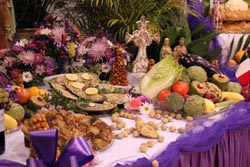
It is only natural that food would be the centerpiece of a ritual that expresses thanks for St. Joseph's intervention to end a historic famine. In addition to statues and prayer candles, the altar is replete with foods that are connected to both Sicilian and Louisiana heritage, and to the story of St. Joseph and the Holy Family. Drawing on the theme of agricultural plenty, fruits and vegetables are prominently featured on the altar. Fresh artichokes, oranges, apples, celery, eggplants, and lemons are found locally in both Sicily and Louisiana. The Mussos explain that since the climates are similar, Sicilian immigrants felt at home in Louisiana. Likewise, the presence of water in both places makes fish an important dietary staple, holding a special place on the St. Joseph altar.
While these foods celebrate the earth's abundance, some specially prepared dishes honor the altar's cultural, spiritual, and historic origins. No meat is served at the Grandsons of Italy altar, in tribute to St. Joseph and the spirit of sacrifice. The absence of meat also refers to the traditional diet in Sicily, where meat was scarce and fish was plentiful. Pasta is prepared with a tomato sauce cooked with hard-boiled eggs, which take the place of meat. Another staple on the menu is Pasta con Sarde (Pasta with Sardines). Grandsons of Italy cooks garnish their pasta dishes with mudica, rather than parmesan cheese. Mudica is made from breadcrumbs and sugar that are baked for a long time. Sprinkled over pasta, Mudica resembles sawdust, a visual reference to St. Joseph's profession as a carpenter. Bread is baked in symbolic shapes, including sandals, staffs, crosses, ladders, palm leaves, and rosaries, among others. Sandals represent the footwear worn by Joseph and Jesus, alluding to the simpler times in which they lived. The staff symbolizes Joseph's walking stick, with which he is always depicted. The presence of bread on the altar is itself significant, as Sicily was for centuries considered the breadbasket for all of Italy. And no St. Joseph altar would be complete without a dish of lucky fava beans, symbolizing hope. Some carry a fava bean from a St. Joseph altar in their wallet, to ensure that they will always have enough money, or for luck in general.
St. Joseph altars are traditionally composed of three tiers. Betty Schoettle relates that the number three represents the Holy Trinity—the Father, Son, and Holy Spirit. Carolyn Musso explains that the three tiers represent Mary, Joseph, and Jesus, the Holy Family. Folk traditions are dynamic, always given to variation and multiple interpretations.
The processes of preparing and dismantling the altar are themselves imbued with symbolism evocative of the historic drought and famine in which the tradition originates. Both the Mussos and Betty Schoettle refer to the tradition of "begging," wherein those coordinating a St. Joseph altar must ask others for altar components or the funds to pay for them. The practice of begging is meant to replicate the humbling experience of having to ask for help, fostering empathy for those who are without food or money to buy it.
Dismantling the altar and distributing its contents upholds the promise made to St. Joseph at the time the first altar was made. According to the Mussos and Betty Schoettle, one constant over time is the tradition of donating some of the foods from the altar to others in the community, in the spirit of "feeding the entire town." Any food left over from the altar is donated to local food pantries, homeless shelters, or other organizations that channel the food to those in need. Proceeds from a donation box on the altar go towards feeding the hungry and also serve as seed money for the following year's altar.
Many Hands Make for a Community Tradition: Cakes, Cookies, and Pastries
Cakes and cookies hold an important place on the altar. Highlighting the transatlantic connection, special fig cakes, or cuccidati, are made from a fig filling surrounded by dough that is cut into in lacy designs. The invocation, "St. Joseph Pray for Us," is often seen on cuccidati, alluding to his intercession on behalf of those who turn to him for help. Cuccidati decorated in the shape of a chalice or monstrance symbolize Holy Communion. Making cuccidati is a specialized skill, requiring the labor-intensive preparation of the fig filling, and painstaking work with the dough. Today, there are few who know how to make cuccidati. Betty Schoettle and some of her altar cake crew from the Church of the Immaculate Conception in Denham Springs have taken a class from a cuccidati master in order to keep this tradition a part of their St. Joseph altar.
Cyrpess Springs Mercedarian Prayer Center, Grandsons of Italy, and Ollie Steele Burden Manor
Not only are cuccidati designs symbolic, but the figs themselves make the connection to biblical times and to Sicilians' home country. Figs are a main crop in Jerusalem and along the Mediterranean coast, including Sicily. Many Italian families in Baton Rouge have fig trees growing in their backyards. The Mussos suggest that Sicilian immigrants are likely the ones who brought fig trees to the area.
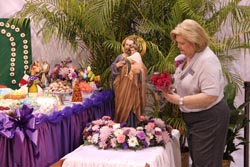
As a founding member and president of the Grandsons of Italy, Anthony Musso helps solicit donations for the altar. A number of area businesses are Italian-owned and they often contribute goods or funds. For these businesses, the donations constitute a blessing. Carolyn Musso organizes the baking of traditional cookies for the Grandsons of Italy's annual St. Joseph altar. She calculates the quantities of flour, sugar, and other ingredients needed in baking items for the Grandsons' altar, so that Anthony can request the correct amounts from the companies who donate them. In a given year, the baking crew might use as many as 162 pounds of sugar and 72 pounds of powdered sugar.
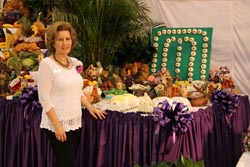
Along with other Grandsons of Italy members, the Mussos coordinate baking and cooking sessions during the six weeks preceding the altar. A printed schedule of cooking and baking sessions goes out to all of the volunteers. Most of these sessions take place during weekends, when many are off of work. As many as 35 to 40 volunteers may help prepare for the Grandsons' altar. The Mussos and other Grandsons members take turns cooking a meal for those who come out to help. The first items that are prepared for the altar are Italian-style casseroles, since they can be made in advance and frozen. Some area restaurants contribute to altar preparations by allowing Grandsons of Italy members and volunteers to use their kitchens during off hours. They also make space in their freezers for storing the dishes that are made in advance.
During the weeks leading up to the Grandsons of Italy altar, Carolyn Musso takes the lead in cookie preparation. Among the standard repertoire of traditional Italian cookies appearing on St. Joseph altars are fig cookies, sesame seed cookies, anise cookies (also known as "rock cookies"), and pignolatas ("haystacks" or "pine cones"). In addition to the cuccidati, smaller iced fig cookies are part of the tradition. Pignolata cookies represent the pinecones that Jesus and his contemporaries played with as a toy. It is thought that children would toss the pinecones around, instead of a ball. Carolyn explains that this reference is not so much biblical as historical. People were poor and they didn't have a lot. Pignolata dough is made from flour and egg. Little pieces of dough are fried and then held together with a syrup made from honey, or from sugar and butter that are melted down to make a caramel coating.
Another sweet offering always found on St. Joseph altars are cakes. At the Grandsons of Italy altar, lamb cakes, representing peace, appear on the main altar with the rest of the food. The other cakes are often displayed on a separate table near the altar. Eddie and Nickie DiMaio are among the Grandsons of Italy founders and are very active in the altar preparations. Eddie coordinates the cakes for the altar each year. She is an accomplished baker and cake decorator, and makes many of the cakes for the altar herself. The cakes are carved and decorated in various altar-themed designs, including the Bible and crosses, among others. Thanks to the marvels of modern technology, a likeness of a St. Joseph prayer card can be printed directly onto a fondant sheet and placed atop the cake. This process can be costly, so Betty Schoettle asks friends to save Christmas cards containing images that could be used to decorate cakes. Betty laminates the cards and nestles them directly into the frosting on top of the cake. Bible cakes are often "open" to particular pages, showing a psalm like You Are My Shepherd, the Ten Commandments, or other passages that are important to those who make the cakes. Sometimes the prayers are written in Italian.
In Denham Springs, Betty Schoettle and a crew of dedicated volunteers prepare intensively for the Church of the Immaculate Conception and the Cypress Springs Mercedarian Prayer Center altars. Betty and her late husband Milton used to bake and decorate around twenty cakes for the Immaculate Conception altar each year. When Milton became ill, fellow church members began helping to make and transport the cakes. Eventually, the cake operation moved entirely to the Immaculate Conception kitchen. Not only do church members volunteer, but others who happen to come to the church for community meetings also become involved. Betty is happy to train volunteers but she finds that many either have previous baking and cake decorating experience or an innate gift for this work.
Betty explains that the carved cakes made for the altar contain sacred designs. Many have to do with the Holy Family, representing Jesus Christ, Joseph, or Mary. Symbols might include the Sacred Heart of Mary, the Sacred Heart of Jesus, the crucifix, or the Crown of Thorns. Given the time of year, Easter cakes and symbols of rebirth are often seen on St. Joseph altars. For Betty and her crew, coming up with new designs and finding ways to create them through both innovative and tried-and-true techniques is an annual delight and challenge, a testament to their creativity and ingenuity. The group uses cake molds, butter cream frosting, candies and other decorative elements to do this work.
Some of the cakes are taken from the Immaculate Conception altar to the Cypress Springs Mercedarian Prayer Center altar each year. As with the Grandsons of Italy altar, the Immaculate Conception altar crew "begs" for donations of food, groceries, cake mixes—whatever is needed to make the altar. Betty buys some of the ingredients, which she considers her donation, along with her contribution of time and talent. Proceeds from the Immaculate Conception altar go towards seeding the following year's altar, covering those items that are not donated, as well as to St. Vincent de Paul and to Immaculate Conception's Right for Life youth program.
Rosary Cakes and Cookies
One unique St. Joseph altar tradition is the rosary cake. In this context, a rosary is made from "beads" that are small round cakes, arranged on a table in the form of a rosary. As in a regular rosary, the ends connect at a center piece, culminating in a cross. Rosary cakes are generally laid out on a table that contains a statue of the Virgin Mary.
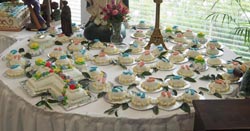
Betty Schoettle remembers seeing a rosary cake for the first time in around 2001, at St. Mark's Church in St. Bernard Parish in New Orleans. Her father used to make bread rosaries, strung on a wire, for the St. Frances Cabrini altar in New Orleans. It was not until she lived in Denham Springs that she tried her hand at making her own rosary cake. Now, it is a regular part of her St. Joseph altar cake repertoire. She makes a rosary cake for the altar at her home church, Immaculate Conception in Denham Springs, which is then moved to Cypress Springs Mercedarian Prayer Center altar.
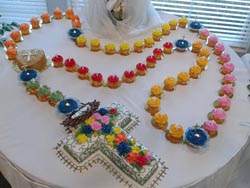
Each year, Betty's rosary cake has a theme. Her first rosary cakes had floral decorations on each bead. One year, the flowers were roses, in honor of the Virgin Mary. Recently, the rosary cakes have reflected contemporary issues. In 2015 the theme was cancer and cancer treatment, paying tribute to a Church of the Immaculate Conception member who had been very active in the church and who had died of cancer. That year, the altar was dedicated to her memory. Each bead in Betty's 2015 rosary was decorated with a colored ribbon symbolizing a different kind of cancer. Betty researched the colors associated with different types of cancer and provided an explanatory key that accompanied her rosary cake, so that altar visitors could understand the symbolism of each color. Betty makes her "beads" with a small round cake mold that would be used to make a ball for a baseball-themed cake. The ribbons were made from candy, using special molds.
made by Betty Schoettle, Frances King, and Mary and Louis Landry
In 2016, the rosary cake made by Betty Schoettle and friends was designed to foster an awareness of the unborn child and the sanctity of life. Betty explains that Frances King, a member of the St. Joseph altar cake crew, had the idea for this theme, which was inspired by the Catholic Church's stance on abortion. Each bead in this rosary cake contains a baby footprint, and a lifelike baby made from fondant is nestled near the cake. The rosary's center piece was decorated with an image of Our Lady of Guadalupe, who is considered the Patroness of the Unborn. The 2016 rosary cake beads were "joined" with yogurt-covered pretzels that resemble links in a chain. "The best thing we ever did," Betty says of this idea.
Baker and cake decorator Debbie Daigle also made a rosary cake for the 2015 Cypress Springs St. Joseph altar. Retired from the military, Debbie began decorating cakes as a hobby when her husband took up cake carving, inspired by the cake television shows that highlighted this art form. Debbie made themed cakes for friends' birthdays and other special occasions, including St. Joseph altars. Italian Catholic by descent, Debbie had not been familiar with the St. Joseph altar tradition before moving to Louisiana. She often provided cross cakes as a donation to friends' private home altars, mostly in West Baton Rouge.
In 2014, Debbie opened Another Piece of Cake Bakery in Central, where her business has flourished. In 2015, through mutual friends, Debbie was approached by someone who wanted to donate a rosary cake to the Cypress Springs Mercedarian Center's St. Joseph altar. Debbie had never heard of a rosary cake. Always game for a challenge, she enthusiastically accepted the offer. She and her husband worked together to design and create the cake. Ever the perfectionist, she researched the rosary to be sure that the cake had the proper number of beads, 55, in the correct formation. Her cross cake, the culmination of the rosary, was decorated with a colorful spray of flowers. The center piece connecting the ends of the rosary was a miniature heart-shaped cake that was air-brushed in metallic gold, with a gold cross on top. Her "beads" were composed of cupcakes, each topped with a butter cream rosette. The five decades (the ten beads on a rosary for which Hail Mary's are said) were iced with a color from the floral spray on the cross. The Mystery Beads, which evoke an event in the life of Jesus or Mary, were topped with a tea light that was nestled in the frosting so that only the flame was visible. Debbie's husband created a Crown of Thorns by dipping pretzel sticks in chocolate and arranging them around the top of the cross.
When she arrived at Cypress Springs to lay out her cake, Debbie was awed by the St. Joseph altar. It was her first experience of a public altar, which was on a much grander scale than the private home altars she had attended. She remembers, "It was amazing. There wasn't a wide [angle] lens wide enough to capture it—it was huge!" Debbie and her husband set up the rosary cake on site, laying out the rosary as it would naturally appear on a table. With her busy bakery to run, she was not able to stay for the altar ceremony and meal, but she was told that whatever food was left over from the altar would be distributed to local shelters for the homeless and others.
Carolyn Musso creates cookie rosaries for the Grandsons of Italy St. Joseph altar, an innovation that came to her some years ago. To make her cookie rosary Carolyn uses the traditional sesame seed cookie dough and bakes the cookies around a skewer. After they are baked, the cookies have a hole through which Carolyn passes a colorful ribbon. Carolyn preserves the rosary's shape by hot-gluing it onto a board. Among her favorite designs over the years was a cookie rosary decorated in the colors of the Italian flag—red, green, and white. Carolyn explains that she was inspired to make a cookie rosary by her special devotion to Mary. Anthony observes that even as people honor St. Joseph at the altar, it is important to remember Mary, the mother.
Viewing and Visiting the Altar
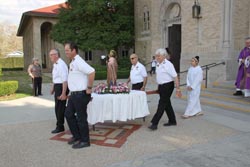
In recent years, the Grandsons of Italy altar has been held in the gym at the Sacred Heart of Jesus Catholic Church and School. Since it takes place at a school, the altar is held during the weekend closest to March 19th. Generally, the altar is ready by noon on Saturday. The altar begins with a 4:00 mass, to which four Grandsons of Italy members carry a statue of St. Joseph. Following the mass, there is a procession back to the gym, where the statue is placed on a table near the altar. At this point, a priest blesses the altar with holy water, along with all the prepared foods in the kitchen. After the blessing, the public is invited to view the altar. The Grandsons offer their guests cookies and wine to enjoy as they view the altar.
The following day, the altar opens with a ceremony featuring the Tupa-Tupa, a pageant featuring the Holy Family visiting the altar. "Tupa-tupa" is Italian for "knock-knock", representing the Holy Family's door-to-door quest for food and shelter. The Holy Family is portrayed by community members. The Grandsons of Italy pageant always features children as the actors, as a way of involving young people in the altar and keeping the tradition alive for future generations.
During the Tupa-Tupa, the Holy Family approaches the Grandsons of Italy members and their guests. First Joseph asks, "Do you have room at the inn?" The audience tells him, "No." Next, Mary asks the same question and receives the same response. Finally, when Jesus asks the question, he is told, "Yes, come in." The Holy Family takes their place at a small table facing the audience, and are served a sampling of all of the foods from the altar.
Once the Holy Family has eaten, they greet the guests and often hand out lucky fava beans, a rosary, or other favors. As they go through the receiving line, visitors can stop by the altar and request various items to take home. The guests are then invited to the cafeteria, where they partake of a meal. Visitors are served both from the kitchen and from the altar itself. Cakes from the dessert table are taken to the kitchen and cut and served to the guests. Visitors have the opportunity to see the altar one more time before it is dismantled. At the end of the altar, guests claim any items they requested, and may "buy" the altar cakes to take home. Along with funds collected in the altar's donation box, proceeds from these sales go towards feeding the hungry and also serve as seed money for the following year's altar. At their 2015 St. Joseph altar, the Grandsons of Italy hosted 600 visitors, of which 475 stayed for the meal.
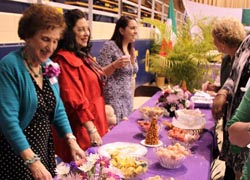
Visitors are sent home with bags containing at least two of each type of cookie. Sometimes the altar hosts prepare an additional favor for visitors to take with them. In 2015, guests at the Grandsons of Italy altar received a plastic bag tied with a decorative ribbon, containing a St. Joseph prayer card, a lucky fava bean, and a piece of bread. The bread has special significance, especially for residents of southwestern Louisiana, where the weather has an enormous impact on people's lives. Anthony Musso explains that people take home the piece of bread and put it in their freezer. When there is a storm, they can tear off a piece of the bread and throw it outside. Appealing to a miracle performed by St. Joseph, this practice is thought to calm the storm, as well as those who are going through it. Anthony remembers his parents doing this. Because of this custom, altar guests might request a hunk of bread from the altar. In the publication Gumbo Ya-Ya, there is mention of St. Joseph's Bread among the favors that people take home from an altar. In this source the bread is believed to prevent those who keep it in their home from starving, and there is also a reference to the practice of throwing the bread out the door for protection from a storm (Saxon, et. al. 1945: 99).
A Tradition for All: The Importance of St. Joseph Altars
Originating in Sicilian culture, history, and spirituality, the St. Joseph altar tradition has been carried on across generations and miles, and remains a special time for Sicilian-Americans, as well as the broader community in southwestern Louisiana. In spite of the altar's transition from private homes to public venues, many of the traditional foods and customs have remained the same in the Louisiana version of this tradition.
The Mussos explain that those who attend the altar and partake of the food come away with a blessing. Some altar visitors bring their own St. Joseph statues to be placed on the altar and blessed by the priest. Carolyn shares the story of a woman whose faith in St. Joseph was so strong, she asked her daughter to bring a platter of fruit, vegetables, and flowers to a St. Joseph altar, after she passed away. When the mother died, her daughter called Carolyn, requesting permission to fulfill this promise. Carolyn reports that the daughter arrived with a large, beautiful platter in her mother's memory.
In Betty Schoettle's experience, people write petitions to St. Joseph on a prayer card and put them in a prayer basket. Some people give a monetary donation along with their prayer. At the Church of the Immaculate Conception, the prayers are put on the altar as an offering on St. Joseph's Day. Betty explains that this is a carryover from the time when the altars were more commonly held in private homes. In this context, altar hosts often burned the prayers, sending them up to God as incense. In this way, the altar host ensured that the prayers remained private, between an individual and God. The altar host merely provided a way for the petition to be made.
Over the years, Anthony and Carolyn Musso have seen the altar tradition's significance expand beyond the Sicilian community. The accounts of St. Joseph altars in New Orleans, as documented by Works Project Administration and Louisiana Writers Project researchers, reveal that they have long been popular among African American community members, including Mardi Gras Indians. At the time the authors of Gumbo Ya-Ya conducted their research it was not uncommon for African Americans to visit altars, or make their own.
Even so, the authors posited:
But Saint Joseph's Day, with its altars, celebrations and religious ceremonies, belongs to the Italians. And the altars are by no means confined to New Orleans, though they are perhaps more numerous and more elaborate there, but may be found in all sections of Louisiana where Italians reside.
Proof of their devotion to this saint is the fact that a recent tabulation of names given to boys in New Orleans showed that 'Joseph' was far in the lead of all others and had been for a number of years. Perhaps Saint Joseph's appeal to them lies largely in their knowledge that he was one of the common, hard-working people of the world like the vast majority of mankind. Someone in the Times-Picayune of March 13, 1937, framed it in these words:
Saint Joseph is loved by his followers as a man among men, a carpenter who worked as men must work, who grew hot and tired as ordinary people do, who smashed his thumb with his hammer and got splinters in his hands-and yet was deemed worthy to live as the husband of the Mother of God (Saxon, et. al. 1945: 106).
Carolyn Musso shares a story from a recent altar that illustrates the broader significance of the St. Joseph altar:
You know, people of all races come to our altar, okay? And I have this one lady who, for the past few years, I would see her. And she came up to me last year, and I was kind of tired. I'd had some sicknesses, and [was] kind of going, 'Oh, I can't do this any more.' She came up to me and she said, 'You know'—she was a Black lady. She was from New Orleans. And she said, 'You know what? You've got to keep doing this.' And she didn't even know I'd been sick or anything, or thinking about stopping. She says, 'This is all about family. It doesn't matter what race you are—Black, white, whatever.' She said she was trying to bring her sons to the altar because she says she wants them to see the meaning of family. She says, 'This is the best symbol that we could ever have for continuing along in what we're trying to teach to our children. You know, the father, the mother, and the son. We can't let it die out.' And so that's what I'm saying—now, it's not just the Sicilians. It's becoming a tradition for other races, also. It's a meaning. . . . The values we want to instill in our children and grandchildren. And that's what was passed down to my husband, to me, our families. Just the importance of family.
Sources
Daigle, Debbie. 2015. Another Piece of Cake Bakery. Interview by Laura Marcus Green. April 2.
Dimaio, Eddie. Grandsons of Italy. 2014. Fieldnotes by Maida Owens. March 15.
Grymes, Debi. Cypress Springs Mercedarian Prayer Center. 2015. Field notes by Maida Owens. March 15.
_____. 2016. Field notes by Maida Owens. March 19.
Musso, Carolyn. Grandsons of Italy. 2014. Field notes by Maida Owens. March 15, March 16, March 18.
_____. 2015. Field notes by Maida Owens. March 14.
Saxon, Lyle, Edward Dreyer, and Robert Tallant. 1945. Gumbo Ya-Ya; A Collection of Louisiana Folk Tales. Cambridge: The Riverside Press.
Musso, Carolyn and Anthony. Grandsons of Italy. 2015. Interview by Laura Marcus Green. March 31, 2015.
Schoettle, Elizabeth (Betty). 2015. Interview by Laura Marcus Green. April 2.



